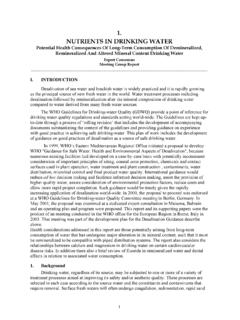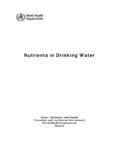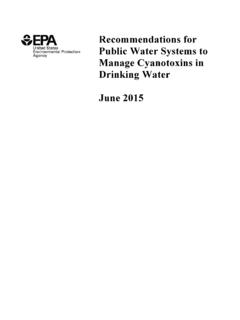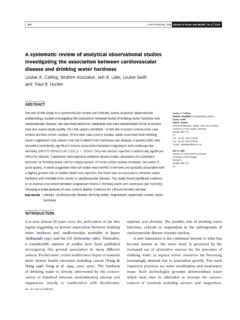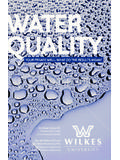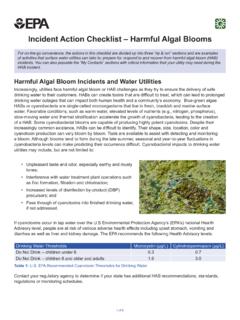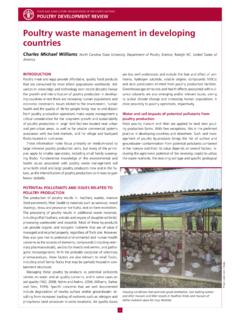Transcription of Chester Water Authority 2017
1 2016 Chester Water Authority 2017. PWS ID# 1230004 Water QUALITY REPORT. Este informe contiene informaci n importante acerca de su agua potable. Haga que alguien lo traduzca para usted, hable con alguien que lo entienda. (This report contains important information about your drinking Water . Have someone translate it for you or speak with someone who understands it.). A Message from Our Executive Manager On behalf of Chester Water Authority (CWA), I am pleased to share our 2017 Water Quality Report, which is also known as a Consumer Confidence Report (CCR). This report includes all Water quality data based on testing performed between January 1, 2017 and December 31, 2017. As you review this report, you will notice that we continue to supply Water that meets or exceeds all state and federal drinking Water standards. This CCR was produced in accordance with regulations by the United States Environmental Protection Agency (US EPA) and the Pennsylvania Department of Environmental Protection (PA DEP), and contains information on the communities we serve, the Water sources we use to produce your drinking Water , the 2017 testing results, educational information on your drinking Water , and our contact information.
2 Water is essential for public health, quality of life, fire protection, and economic development. CWA. employees are committed to providing our customers with high quality drinking Water . Please review this report to learn about the source of and the quality of your drinking Water . As always, CWA welcomes your questions about this report, your drinking Water , and our organization. Please share this information with other people who drink this Water , especially those who may not have received this notice directly (for example, people in apartments, nursing homes, schools, and businesses). You can do this by posting this notice in a public place or by distributing copies by hand or by mail. For an electronic copy of our 2017 CCR, please go to If you would like more information regarding this report, please contact our Customer Service Department at or , or visit our website at: At CWA, we take pride in our ability to provide our customers with high quality Water and reliable service.
3 We value our customers and are committed to keeping you informed about your Water quality. CWA. appreciates the opportunity to serve you. Robert A. Judge Executive Manager About Chester Water Authority CWA is a Pennsylvania Municipal Authority that was established in 1939 to provide potable Water to our customers. We are a public Water supplier, but we are not a for-profit organization. CWA serves the following areas: Aston Township Franklin Township New London Township Bethel Township Kennett Square Borough Oxford Borough Birmingham Township Kennett Township Parkside Borough Brookhaven Borough Londonderry Township Penn Township Chadds Ford Township London Grove Township Pennsbury Township Chester Heights Township Lower Chichester Township Thornbury Township ( Chester County). Chester Township Lower Oxford Township Thornbury Township (Delaware County). City of Chester Marcus Hook Borough Trainer Borough Concord Township Middletown Township Upland Borough East Marlborough Township Nether Providence Township Upper Chichester Township East Nottingham Township New Garden Township Upper Oxford Township Page 1.
4 Where Does Your Water Come From? The Water treated at the Octoraro Treatment Plant comes from two sources: the Octoraro Reservoir and the Susquehanna River. Both of these sources are in the Susquehanna River Basin. The Water is treated and pumped to our customers from the CWA Octoraro Treatment Plant which produces an average of 30. million gallons per day. The US EPA and PA DEP have established regulations that require public Water systems to monitor for certain contaminants. They have also set limits for the amounts of contaminants that may be present in (Octoraro Reservoir in Lancaster County, PA). drinking Water . As your Water supplier, we recognize that contaminants may be present in source waters and we operate the treatment processes of the Octoraro Treatment Plant to ensure the Water we provide to our customers meets all drinking Water standards. Source Water Protection Plan and Source Water Assessments In 1988, a Source Water Assessment (SWA) of the Octoraro Reservoir was completed by the Cadmus Group.
5 The SWA identified and ranked sources of potential threats of source Water contamination. The SWA. indicated that the Octoraro Reservoir was most susceptible to contamination by nutrients and sediments from agricultural activity. Other potential sources of contamination include spills from roads and bridges, residential and municipal wastewater treatment, urban storm Water runoff and industrial discharges. To better protect the source Water in the Octoraro Reservoir, CWA and PA DEP used the SWA as a foundation to develop a Source Water Protection Plan (SWPP) that was finalized in July 2015. The SWPP is a voluntary effort by interested parties or stakeholders to take action to prevent contaminants from entering CWA's Octoraro Reservoir. The goal of the SWPP is to improve and protect the quality of the surface Water within the Octoraro's 139 square mile watershed and within the Octoraro Reservoir. Improved Water quality will benefit our customer's drinking Water , as well as residents and businesses within the watershed.
6 CWA hosts an annual steering committee meeting to continue protection efforts and to gain public participation and support. The steering committee is made up of residents, township officials, regulators, conservation districts, and other partnering stakeholders. The stakeholders include the Octoraro Watershed Association Safe drinking Water Starts at the Source! (OWA), the Alliance for the Chesapeake Bay, the Chester County Water Resources Authority , and the Lancaster County and Chester County Conservation Districts. In addition to the Octoraro SWPP, the Susquehanna River Basin Commission (SRBC) completed a SWA for the Susquehanna River Conowingo Pond in 2003. The SWA indicated that Conowingo Pond was most susceptible to contamination from agricultural contaminants, spills from roads and bridges, and urban storm Water runoff. Other potential sources of contamination include discharges from wastewater treatment plants, Water treatment plants, and industries.
7 A summary report of the Susquehanna River Basin assessment is available on the Pennsylvania Source Water Assessment website at: Complete reports were distributed to municipalities, Water suppliers, local planning agencies, and PA DEP. offices. Copies of the reports are available at the PA DEP Southeast Regional Office at , or by calling CWA at Information about the Octoraro Watershed Association (OWA) may be obtained by contacting OWA directly at 517 Pine Grove Road, Nottingham, PA 19362, or by calling Page 2. Frequently Asked Questions Why is my Water discolored? If your Water is rusty, yellowish, or brownish, the color is likely a result of iron or rust. This may occur when there is an upset in the distribution system (such as a Water main break) or when the direction of Water flow changes (such as during hydrant use to extinguish a fire or during routine hydrant flushing). Discolored Water may also result from internal plumbing issues.
8 A rust problem is usually short-lived and we recommend that you do not wash clothes if you notice discolored Water because the clothes may stain. Flush your cold and hot Water taps, after the Water clears, to make sure the rust does not accumulate or stay in your plumbing. Why does my Water appear milky? When Water is cold, such as during the winter, there is more air in it. When the cold Water enters your home, the Water warms up and air is released from the Water . The air in the Water will give it a milky or cloudy appearance. So, when you open the faucet to fill a glass, the air is released as bubbles similar to what you see when shaking a soda. As the Water sits in the glass, it will clear from the bottom of the glass to the top. The air is not harmful. The more air in the Water , the longer it will take for the Water to clear and more cloudy or milky it looks. Why is there pink slimy material in my toilet bowl, my pet's dish, my sink drain, bathtub, or shower head?
9 Bacteria grow well in these areas because they are moist and provide a food source for the bacteria to thrive on. The bacteria can be found in the air, in soil, in Water , or on household surfaces. Orange and pink are common colors for many bacteria, but the bacteria known as Serratia marcescens is often the source of the orangy/pink stuff . This bacteria is not easily eliminated from these areas. Periodic and routine cleaning of these areas followed by disinfection with a chlorine-based cleaner is the best way to control it. What are these black particles in my Water ? Black particles may arise from a broken household Water filter that contains a carbon cartridge and the particles will look like coffee grounds. If you see particles you should replace the cartridge. Black particles may also be a result of a degrading faucet washer or gasket or a disintegrating black rubber liner inside a woven stainless steel flexible hose used in many plumbing connections.
10 These particles are often described as small, like a spec of black pepper or oily;. you should replace the washer, gasket, or hose. Choose a hose with a different style that does not contain a black rubber liner. Why does my Water smell like rotten eggs or sewage? If you notice a smell similar to rotten eggs (sulfur) or sewage when running Water , it might be caused by gases residing in the sink drain. In the drain, bacteria live on food, soap, hair, etc. When Water goes down a drain, these gases are released into the air. These odors are often mistakenly associated with the Water because they are observed only when the Water is running. In this case, the odor is not in the Water , it is merely the Water pushing the gas out of the drain. You can confirm this by getting a glass of Water from the faucet and carrying it away from the sink and drain. If the odor is coming from the drain, the odor will not be noticed in the glass of Water once you move away from the sink drain.

